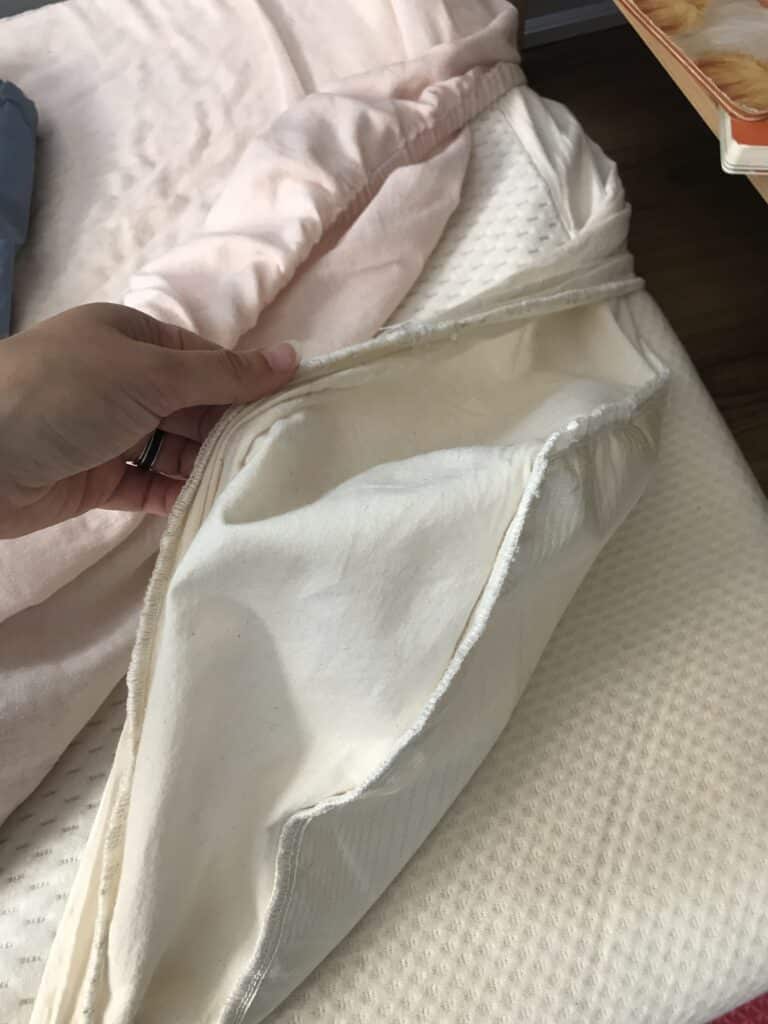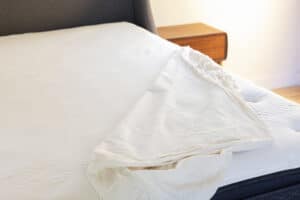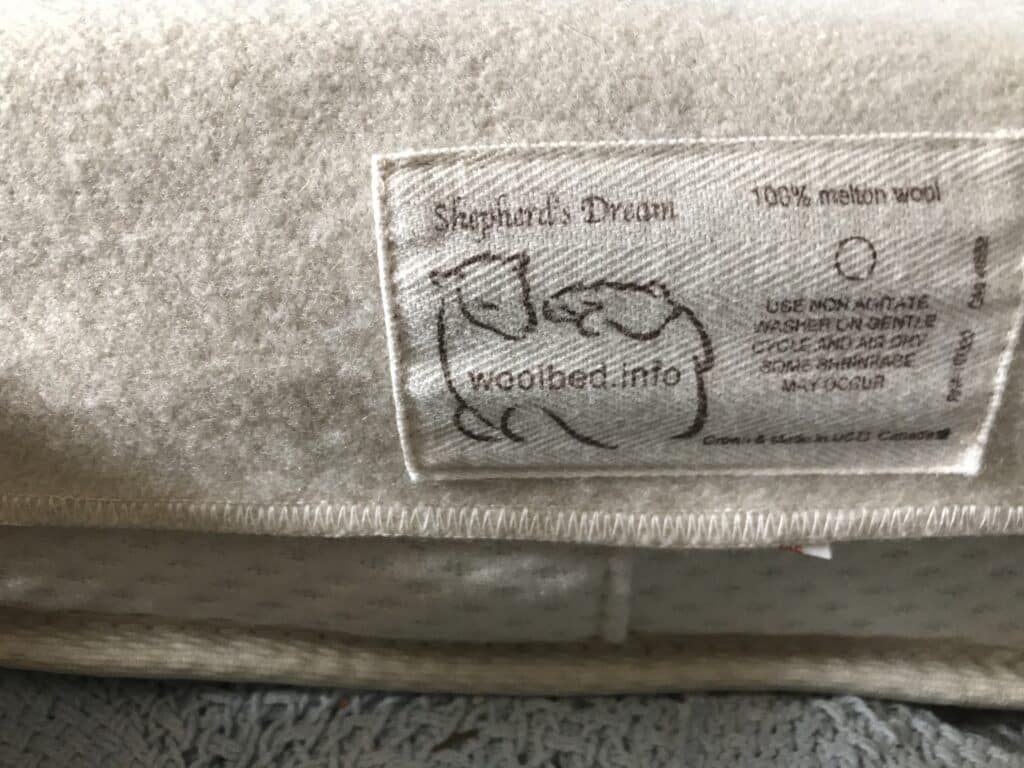Babies make messes. As parent to a little one, I know this only too well. And that means it’s a good idea to protect your baby’s crib mattress. Are waterproof mattress protectors safe for babies, though? Here’s my take on this contentious issue, as a parent and Head of Research at Leaf Score.
When I think of waterproof mattress covers, I usually think back to the noisy, sweaty, uncomfortable vinyl mattress protectors I had to sleep on as a child. These were always one of the worst parts of being on vacation or sleeping on an unfamiliar mattress as I didn’t have one on my own bed at home (thankfully!).
These days, though, there are much better options for waterproof mattress protectors. Sure, vinyl, PVC, and polyester mattress protectors still make up most of the market, but organic, noise-free mattress protectors also exist.
Are these mattress protectors truly safe for babies, though, and do you really need a crib mattress protector in the first place?

Why I recommend crib mattress protectors
Babies spend a lot of time sleeping in their crib. Babies also pee, poop, and spit up, sometimes in their sleep. Even with the best Elimination Communication practices, cloth diapering, or disposable diaper use, leaks and accidents happen. If those happen on an organic, non-toxic, ‘breathable’ mattress, you have a problem.
Many organic mattresses don’t have a waterproof cover. Many don’t even have a water-resistant cover. That can mean any fluids quickly soak through the crib sheet and into the mattress. Because you can’t fully wash a crib mattress, your only option is to try to soak up as much of the mess as you can, then spot clean and air dry.
The upshot is that even a tiny amount of microbial contamination can lead to mold, mildew, fungus, and other issues in a crib mattress. This makes the crib mattress unsafe for babies.
Not having a mattress protector can cause avoidable stress (in the middle of the night!), which no one needs while caring for a newborn or infant. It also means more expense and resource use when you inevitably need to get a replacement.
Unless your crib mattress has a built-in waterproof cover, I strongly recommend using a separate, washable crib mattress protector. At the very least, use a water-resistant wool puddle pad to minimize soiling of the crib mattress itself.
What’s in your baby’s mattress protector?
Many waterproof crib mattresses have a cover made with thermoplastic polyurethane (TPU) or polyurethane. The same goes for the waterproof layer in most crib mattress protectors. Some waterproof covers are made with polyester, vinyl, or polyvinyl chloride (PVC), though, and I strongly recommend avoiding these, particularly for crib mattresses.
Polyester, PVC, and vinyl are a poor choice for waterproof crib mattress protectors because they:
- Are made with toxic chemicals that can off-gas and leach
- Typically contain endocrine disruptors such as BPA and alternatives
- Can cause overheating, sweating, and then chills
- Shed microplastics when washed and dried
- Break down quickly with heat, flexing, light, and moisture
- Don’t biodegrade and are hard to recycle.
PVC and vinyl can also be noisy and feel crunchy, both of which make for an uncomfortable sleep surface for infants and young children.
Because babies, especially very young infants, are at a higher risk for overheating, any mattress protector that traps heat is a bad idea. Babies are also growing at a rapid rate, which is why I and other parents try hard to minimize exposure to chemicals like BPA and phthalates that can disrupt normal development.
Finally, given my toddler’s newfound delight in bouncing on the bed, I would not want a mattress protector that tears easily. PVC, vinyl, and most laminates are very easily ripped and punctured, which rapidly compromises their efficacy, meaning your mattress isn’t actually protected at all.

Essential Mattress Protector
100% GOTS-certified cotton mattress protector. The Essential Mattress Protector has an earthy, natural feel. The fitted, lightweight pad is waterproof, machine-washable, and dependable in protecting your mattress from life’s little accidents.
Use code LEAFSCOREREADER to take 10% off any bedding item in the LeafScore online store.
What about polyurethane and TPU in crib mattress protectors?
Okay, so you’re avoiding some of the most common waterproofing materials for crib mattress protectors. What’s left?
Thankfully, many bedding companies have begun offering fully waterproof mattress protectors made with a thin layer of inert polyurethane or TPU. This waterproof but breathable membrane usually sits beneath or between layers of natural fiber such as wool or cotton.
Depending on how it is made, polyurethane and TPU can be recyclable and biodegradable. And the nice thing about these materials is that they aren’t ‘blown foam’, which means they aren’t made using some of the most harmful chemicals in polyurethane foam. They’re also typically free of phthalates and BPA. And because they’re such a thin layer, they don’t require chemical flame retardants to pass fire safety tests.
Look for waterproof crib mattress protectors with GOTS certification. This means that the waterproof membrane comprises less than 5% of the product and does not contain other chemicals of concern, such as formaldehyde-based adhesives, regulated phthalates, and BPA.
Recycled plastics
I’m yet to see a crib mattress protector made with recycled plastic but if I do, chances are I won’t recommend it at Leaf Score.
While it’s great to see more products made with plastics that would otherwise pollute waterways, oceans, and landfill, not all plastic can be considered circular. This is because recycled polyester or polyethylene has been found to contain a plethora of hazardous chemicals.
Research suggests that all recycled plastics risk exposing us to at least some harmful chemicals. These can even include chemical flame retardants and endocrine disruptors that are now banned in new products in the U.S.
Given the vulnerability of infants and toddlers to any harmful chemicals, I would strongly suggest avoiding most recycled plastic products made for this age group. In particular, I would avoid products that would be in contact with a baby’s skin or any food or liquids they consume, or that they could suck or chew on.
Read more about my concerns over recycled plastic and the research findings here.
Organic, non-toxic crib mattresses don’t usually have a built-in waterproof cover.
The Naturepedic Organic Cotton Classic Crib Mattress does, though, which is why it’s one of my top choices for The Best Eco-Friendly & Nontoxic Crib Mattresses.
Naturepedic’s mattress is fully waterproof thanks to a non-GMO sugar cane derived polyethylene waterproof cover that meets GOTS requirements and is MadeSafe certified.
The rest of the mattress is made of organic cotton and innersprings and there are no harmful chemicals, vinyl or PVC, phthalates, formaldehyde, flame retardants, polyurethane, or perfluorinated compounds (PFCs).
You can read my full review of the Naturepedic Crib Mattress here.
SBR – Synthetic rubber
Some mattress protectors have a soft fabric upper and a layer of synthetic rubber below. These are often marketed as being noiseless and waterproof and a great alternative to vinyl and PVC. Some companies even tout these products as being hypoallergenic and a good alternative to natural latex.
What is synthetic rubber? Also known as SBR, synthetic rubber is styrene butadiene rubber and is definitely one to avoid in crib mattress protectors.
SBR is made from two terribly toxic chemicals. These volatile organic compounds (VOCs), styrene and butadiene, are well known for their significant health effects and environmental impacts (read more about those here). I would never knowingly put an infant down to sleep on a mattress with SBR as it off-gases terribly. Even for older toddlers and children, and for adults, the potential health impacts of this material are too much of a risk to balance out any protection from spills and accidents.
Not only that, SBR is a petroleum product, meaning its production is irrevocably linked to climate change and pollution, both of which will affect our kids more than they affect us currently. And SBR isn’t anywhere near as durable as natural latex as it tears easily, meaning it’s very wasteful and polluting.
Other chemicals in crib mattress protectors
Although some bedding companies give you the run around and don’t list all their materials, it’s usually pretty easy to spot a protector made with materials like PVC, polyester, or rubber.
It’s far harder to find out about any processing or finishing chemicals that went into making the mattress protector. These can include:
- Chlorine bleach (can give rise to carcinogenic dioxins)
- Formaldehyde
- Flame retardants
- Phthalates, BPA, and alternatives
- Synthetic adhesives
- Stain repellants and waterproof coatings (sometimes made with ‘forever chemicals‘, AKA PFCs)
As you might expect, I strongly suggest avoiding all of the above wherever possible, especially for crib mattress protectors. This usually means looking for products made with mostly or all organic materials with GOTS certification or USDA Organic certification plus eco-INSTITUT certification.
I fully understand if, given all of the above, you’re leery of any plastic waterproofing for a crib mattress. The good news is that there is a workaround: wool.
A wooly workaround: How to have a truly non-toxic crib mattress protector
Wool offers a variety of benefits as a crib mattress protector. This natural fiber is:
- Naturally water-resistant
- Moisture wicking
- Flame resistant
- Antimicrobial
- Great for thermoregulation (so your baby doesn’t overheat or get cold)
- Resistant to dust mites, mold, and mildew
- Firm (which you need for a safe sleep surface for infants).
Some crib mattresses have a built in layer of wool below a top layer of cotton. This helps support safe, comfortable sleep and can help protect the inside of a crib mattress from the worst damage following leaks and spills.
While that inner layer of wool offers some peace of mind, I recommend going a step further, especially if you can’t remove and wash the outer layer of cotton from your crib mattress.

My wooly workaround for a truly non-toxic waterproof crib mattress is to use a wool puddle pad between the crib mattress and crib sheet. I was fortunate enough to be gifted two hand-me-down puddle pads, one for a change table or bassinet and one that fits a crib.
This layer of wool helps to protect the mattress and maintains a firm, safe, thermoregulating sleep surface for my toddler and for younger babies. That means they’ll be better able to maintain a comfortable body temperature, whatever the season.
The thing about wool puddle pads, though, is that they only work if they still hold some of the lanolin (an oily substance produced by sheep). If you wash wool in harsh detergents or too frequently, it can quickly lose its natural ability to repel water.
Downsides to wool
While wool is water-resistant, it’s not waterproof. That means you’ll still want to consider a waterproof membrane or mattress under the puddle pad. Or, be ready to clean up messes quickly to avoid damage to the crib mattress. You might want to use two puddle pads for back-up if your baby is prone to big accidents.
Another downside to wool is the potential for allergies to lanolin. Because a puddle pad works by dint of its high lanolin content, the risk of allergy is also higher if your baby comes into contact with the wool. Most often, though, there’ll be a crib sheet between your baby’s skin and the wool puddle pad, so the risk is minimal.
Other downsides of a wool crib mattress protector are cost and the need for more attentive care than with a washable protector. It’s also worth noting that wool isn’t vegan and that wool production does impact the environment and is sometimes treated with pesticides and other chemicals. Choose GOTS wool or EcoWool for a more sustainable, non-toxic option (see important green certifications here).

Essential Mattress Protector
100% GOTS-certified cotton mattress protector. The Essential Mattress Protector has an earthy, natural feel. The fitted, lightweight pad is waterproof, machine-washable, and dependable in protecting your mattress from life’s little accidents.
Use code LEAFSCOREREADER to take 10% off any bedding item in the LeafScore online store.
Final thoughts on the safety of waterproof crib mattress protectors
There’s plenty to think about as a new parent or caregiver to an infant. The ins and outs of waterproofing crib mattresses is low on the list when sleep deprived and trying to soothe a fussy baby. That’s why I recommend doing the research in advance and then snapping up a good deal on a non-toxic crib mattress and waterproof cover when sales happen.
If you’re in the thick of it though and need a crib mattress or cover right now, I highly recommend the Naturepedic mattress (see our review) as a simple one-and-done solution. If you already have a mattress and need to protect it, consider wool puddle pads or a GOTS certified organic cotton waterproof crib mattress protector with a thin layer of TPU or polyurethane.
These kinds of covers are safe for babies, very effective for keeping your crib mattress clean and hygienic, and are far more sustainable than having to replace a soiled and unsafe mattress after one too many messes.
Crib mattresses don’t always have a waterproof cover, especially if they’re organic and non-toxic. We take a look at the safety of waterproof crib mattress protectors and the best kind to keep your baby and their mattress safe.